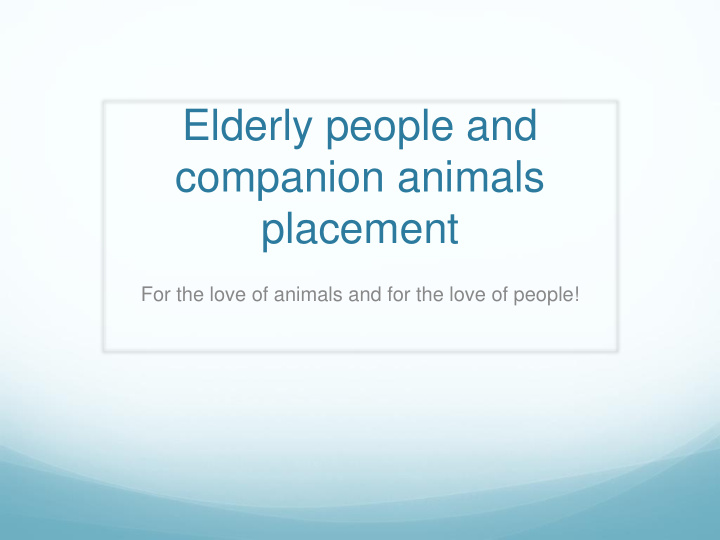



Elderly people and companion animals placement For the love of animals and for the love of people!
How I came to find myself here! Flinders University Master of Social Work student First placement (500 hours July-Dec) Interest in community development Animal lover
Tipperary’s story
History of placement Animals in Society Group Appreciating human animal companion bond and research and practice gaps Desire to enable community engagement and service delivery to encompass companion animals
Conception to birth Joint placement with Anglicare SA Home Care South & West, Active Living RSPCA South Australia Opportunities for inter-agency collaboration and mutual support Demonstrates interconnectedness of human issues and animal issues
Placement details Raising profile and issues of the elderly residing in their own home with companion animals through: Research project Talking and connecting with: Elderly people Service providers & community Encompassing a literature review Culminating in production of a community resource
Early observations Promising! Literature: “My Dog Always Eats First: The Homeless and their Animals” (2013, Irvine, L) Medical, veterinary, gerontology, psychology, nursing, social work & sociology sources on this topic Community: Few surprised by the importance of companion animals to elderly people Two newly acquired dogs to elderly couple story Companion animals more than a risk assessment
Early obs cont. Not everyone is convinced! But Leunig reassures!
Early obs cont. Potential reluctance to plan for separations from companion animals including relinquishment or death (Telecross & other service anecdotes) I s this the individual’s problem? Exciting City of Yarra “Companion Animal Support Program for Older People”
Yarra City Companion animal service cont. Free to residents who are elderly or have a disability Matches volunteers Evaluation case studies insightful Foster care for animals – service gap
An animal’s eyes have the power to speak a great language. Martin Buber (1878- 1965)
Tribute to a dog
What’s not to love in a companion animal… Cat Steven’s ‘I love my dog’ says it all…. I love my dog as much as I love you But you may fade, my dog will always come through. All he asks from me is the food to give him strength All he ever needs is love and that he knows he'll get So, I love my dog as much as I love you But you may fade, my dog will always come through. All the pay I need comes shining through his eyes I don't need no cold water to make me realize that And may we extend these sentiments of love and companionship to all our sentient non-human friends.
Summing up Companion animals hold significant place in the lives of people, especially the elderly (family, attachment theory, grief & loss issues - disenfranchised) Full recognition of this in aged care can be ‘hit and miss’ and focused on risk Supporting the human and companion animal bond has multiple benefits and ripple effects – enabler of social capital There is ample evidence, including research and existing programs, modeling why and how we should support the human (elderly) companion animal bond that fits with the aged care agenda and the language of choice and independence.
The team Placement agencies: Dr Di Evans - Animal Welfare Advocate, RSPCA South Australia Marie Noble - Manager Home Care South & West, Anglicare SA Flinders University : External Field Supervisor - Prof Fiona Verity Field Coordinator - Ilektra Zabanias Placement Student - Mary-Rose Alfonsi
The End! Questions or comments
Selected references Ebenstein H & Wortham J (2001) ‘The Value of Pets in Geriatric Practice: A Program Example’ Journal of Gerontological Social Work, Vol. 35(2) The Haworth Press, Inc. Morley C & Fook J (2005) ‘The importance of pet loss and some implications for services’, Mortality: Promoting the interdisciplinary study of death and dying, 10:2, 127-143 Risley- Curtiss C (2010) ‘Social Work Practitioners and the Human -Companion Animal Bond: A National Study’ Social Work Vol 55(1) National Association of Social Workers Sable P (2013) ‘The Pet Connection: An Attachement Perspective’ Clin Soc Work J 41:93-99, Springer Slatter J, Lloyd C & King R (2012) ‘Homelessness and companion animals: more than just a pet?’ British Journal of Occupational Therapy, 75(8), 377-383 Walsh F (2009) ‘Human - Animal Bond I: The Relational Significance of Companion Animals’, Family Process, Vol 48, No.4, FPI Inc. http://www.yarracity.vic.gov.au/Services/Older-persons-services/home-and-support- services/Companion-Animal-Support-Program/
Recommend
More recommend